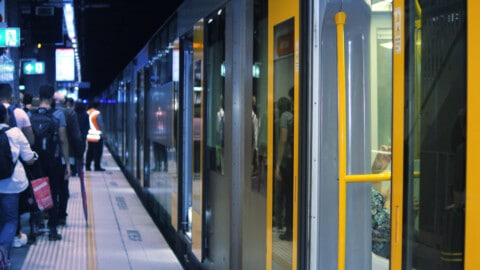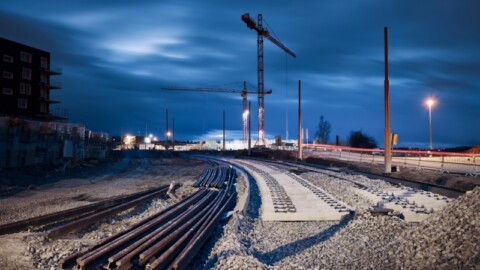The Sydney Harbour Tunnel is a quiet achiever, living in the shadow of the other main way of vehicular traffic crossing, the Sydney Harbour Bridge.

Until the traffic lights were installed, the water screen was used in the Sydney Harbour Tunnel two to three times a week to stop trucks who just weren’t paying attention.
In August 2017, Australia’s only subsea road tunnel celebrates its 25th anniversary. To celebrate this anniversary, create magazine spoke to the Sydney Harbour Tunnel Company’s General Manager, Bob Allen.
“It’s a comment that was made many, many years ago, not by me, but I’ll repeat it, ‘An invisible landmark,’” Mr Allen said.
The quiet achiever, which took over 4,500 people five years to construct, celebrates its quarter-century anniversary in August.
Mr Allen, who was the opening controller at three o’clock of the morning of August 31, 1992, said a crew of about 32 currently ensures the tunnel keeps ticking over.
The 2.3km-long, four-lane-wide tunnel links the Warringah Freeway and Cahill Expressway, and is used by an average of 102,000 vehicles every day.
A number of features have been added over time to ensure the smooth progress of these vehicles, and that the asset is kept modern and relevant.
“The water screen, as we call it, or the Softstop Barrier, was developed after a fire in the tunnel in 2003 and motorists just would not stop,” Mr Allen said.
“Motorists were driving into the tunnel, with a car on fire just over two kilometres into the tunnel – this is northbound – and some motorists did U-turns and then went south in the northbound carriageway, ignoring all the lights and signs in the tunnel which are saying ‘Stop’.”
Developed with Laservision, the curtain of water has light projected onto it, giving the “illusion of a solid surface”.
Fires like the one that prompted its development are thankfully rare, and the signs main use became as a last line of defence against over-height trucks, that have ignored warning lights and signs, from entering the tunnel. Traffic lights were later installed on the southbound approach to the tunnel.
“Until the traffic lights were installed, the water screen was used two to three times a week to stop trucks who just weren’t paying attention,” Mr Allen said.
Over-height vehicles ignoring signs can be a major problem. One kilometre north of the tunnel, at the approach to a pedestrian footbridge, over-height trucks trigger infrared light beams which will change a variable message sign to tell the truck to use the bridge instead of the tunnel.
“And by far, the majority of truck drivers do, you can imagine how many trucks are on the road,” Mr Allen said.
“If they were all dipshits, we’d be stopping every five minutes, so the majority are doing the right thing. It’s just that when the minority screw up, it has a high impact.”
The confined space within tunnels mean that identifying and dealing with fires accurately and quickly is essential. The tunnel has a manually-operated deluge sprinkler system. There is also Vortex fire suppression systems in the control and computer rooms.
Maintenance and operational regimes are also in place to ensure the tunnel is upgraded to keep it modern.
To achieve this the tunnel is closed regularly to allow access for maintenance personnel and contractors to work in a safe environment.
Mr Allen said that computers have been upgraded three times, and a fibre optic network installed “so we can go to an IP protocol… But we are not connected to the outside world so we can’t be attacked by viruses or persons with malicious intent.
“Installing the fibre network and connecting to all devices remains a work in progress, with only about five hours a night available to chip away at the task, which has been running for around five years.
“As part of our obligation to design, build, operate and maintain the tunnel for a 100-year design life, a major project has been undertaken in the last two years which we call the ‘Enhanced Asset Management Plan.’
“The tunnel design and construction has been reviewed, the tunnel subjected to in-depth inspection including non-destructive testing, breakouts and removal of concrete cores. This has allowed best practice plans, the EAMP, to be put in place for the inspection and ongoing maintenance of the actual concrete structure.
“As well, we do an annual 3D survey of the underwater tunnel. Whilst there was some initial movement, this has now stabilised and is less than a one-third of allowable joint design movement.”
The Tunnel Company (a joint venture between Transfield, Kumagai Gumi and Olbia) will operate the asset until 2022, at which point it will transfer to public ownership.
Asked what the biggest challenge was, Mr Allen said it is simply ensuring the tunnel is kept fit for purpose.
“And that everybody comes in one end and goes out the other,” he said.
“And I’m not trying to sound flippant, but that’s really what we’re here for.”
Expand your thinking about the use of underground space at the 16th Australasian Tunnelling Society conference taking place in Sydney from 30 October – 1 November 2017. Find out more at ats2017.com.au.













